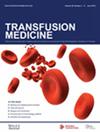人类源性活物质捐赠动机和障碍快速审查及扩展类型。
摘要
我们的目的是回顾非生殖性活体人源物质(SOHO)捐献的动机和障碍,并将现有的类型学扩展到血液之外。目前,活体捐献者人数的增加无法与 SoHO 采集量的增加相提并论。因此,亟需了解如何有效招募和留住捐献者,以确保 SoHO 的可持续供应。我们对已发表的、经同行评审的文献进行了快速回顾和叙述性综合,这些文献报道了活体 SoHO 捐赠(全血、血液制品 [2009-2023]、骨髓/干细胞、脐带血、器官、母乳、肠道微生物群 [2000-2023])的动机和/或障碍。通过使用主要来自献血研究的动机/障碍扩展类型进行定向定性内容分析,对结果进行解释,随后根据结果进行改进,以纳入其他 SoHO。234 篇文章和 237 项研究符合审查标准。大多数研究都是定量研究(74.3%),在西方国家进行(63.8%),关注献血(64.2%),报告献血动机和障碍(51.9%),并且没有研究献血者特征或献血史的差异(74%)。我们对捐献血液以外物质的动机/障碍进行了分类。这表明,虽然各种捐献物质都有广泛的动机和障碍,但在细分类别层面存在关键差异,这可能是先前干预结果不一致的原因。对于采血机构来说,在尝试扩大全血、血浆和血小板以外的产品采集范围时,如何在不同的 SoHO 中体现出大类动机和障碍的细微差别至关重要。对该主题的了解采血机构(BCA)继续扩大全血、血浆和血小板以外的 SoHO 产品采集。目前,活体捐献者的增加无法满足对 SoHO 的需求。了解如何招募新的活体捐献者并留住现有的活体捐献者以确保 SoHO 的可持续供应仍然至关重要。然而,目前还没有对各种因素(如动机/促进因素和障碍/阻力)进行综合分析,以帮助我们理解这些因素。新内容全面回顾了所有类型的非生殖性活体SOHO捐献中自愿/实际捐献者和非捐献者的动机和障碍的证据。探讨了基于物质、捐献历史和人口统计差异(性别、年龄、种族或文化)的捐献动机和障碍的差异。对捐献动机和障碍的类型进行了扩展,包括所有非生殖性活体 SoHO,而不仅仅是全血和血液制品。发现虽然不同物质的总体动机和障碍类别存在共性(如亲社会动机、低自我效能感),但在这些更广泛的结构中,子类别层面也存在差异(如低自我效能感与捐赠资格、生活方式障碍或缺乏/丧失财政或物质资源有关,具体取决于所捐赠的物质),这对未来干预措施的开发至关重要,也是 BCA 在扩大 SoHO 产品收集范围时需要考虑的因素。强调继续关注全血和血液制品捐献的动机和障碍,而忽略了其他,尤其是较新的 SoHO;缺乏针对较新 SoHO 的定性工作;缺乏对基于捐献者特征(尤其是种族/文化)和捐献者历史的差异的考虑,这限制了我们的理解。本专题未来工作的关键问题是什么?捐赠干细胞、脐带血、母乳和肠道微生物群等新型 SoHO 的动机和障碍(定性和定量研究)是什么?SOHO内部和不同SOHO之间的捐赠动机和障碍是否因个人和环境因素而存在差异?我们如何制定干预措施,以应对不同形式的 SoHO 在动机和障碍方面存在的细微差别,从而有效鼓励新的捐赠者并保持持续的捐赠者?Our objective is to review motives and barriers for non-reproductive, living substance of human origin (SoHO) donation, and to extend existing typologies beyond blood. The expansion of SoHO collection is currently unmatched by increased living donors. Thus, there is a critical need to understand how to effectively recruit and retain donors to ensure a sustainable supply of SoHO. We undertook a rapid review and narrative synthesis of published, peer-reviewed literature reporting on motives and/or barriers for living SoHO donation (whole-blood, blood products [2009-2023], bone marrow/stem cells, cord blood, organ, human breast milk, intestinal microbiota [2000-2023]). Results were interpreted through directed qualitative content analysis using an extended typology of motives/barriers largely drawn from blood donation research, and subsequently refined based on results to be inclusive of other SoHO. 234 articles with 237 studies met review criteria. Most were quantitative (74.3%), conducted in Western countries (63.8%), focused on blood donation (64.2%), reported motives and barriers (51.9%) and did not examine differences by donor characteristics or history (74%). We present a revised typology inclusive of motives/barriers for donation of substances beyond blood. This shows while broader motives and barriers are shared across substances donated, there are critical differences at the subcategory level that may account for heterogeneity in results of prior interventions. The nuances in how broad categories of motives and barriers manifest across different SoHO are critical for blood collection agencies to consider as they attempt to expand collection of products beyond whole-blood, plasma, and platelets. WHAT IS KNOWN ABOUT THE TOPIC?: Blood collection agencies (BCAs) continue to expand SoHO product collection beyond whole-blood, plasma, and platelets. The demand for SoHO is currently unmatched by increased living donors. The need to understand how to recruit new and retain existing living donors to ensure a sustainable supply of SoHO remains critical. However, there is no available synthesis of the factors, such as motives/facilitators and barriers/deterrents, to inform our understanding. WHAT IS NEW?: Comprehensively reviewed evidence for motives and barriers of willing/actual donors and nondonors across all types of non-reproductive living SoHO donation. Explored variations in motives and barriers based on substance, donor history and demographic differences (gender, age, ethnicity or culture). Extended typology of motives and barriers inclusive of all non-reproductive living SoHO, beyond solely whole-blood and blood products. Identified that while there are commonalities in the overarching motive and barrier categories across substances (e.g., prosocial motivation, low self-efficacy), within these broader constructs there are differences at the subcategory level (e.g., low-self efficacy was about eligibility, lifestyle barriers, or lack/loss of financial or material resources depending on the substance donated) that are crucial for development of future interventions and for BCAs to consider as they expand SoHO product collection. Highlighted the continued focus on motives and barriers for whole-blood and blood product donation to the exclusion of other, particularly newer, SoHO; lack of qualitative work for newer SoHO; and lack of consideration of differences based on donor characteristics (especially ethnicity/culture) and donor history, which limits our understanding. WHAT ARE THE KEY QUESTIONS FOR FUTURE WORK ON THE TOPIC?: What are the motives and barriers (in both qualitative and quantitative studies) for donation of newer SoHO such as stem cells, cord blood, human milk, and intestinal microbiota? Are there differences in motives and barriers within and across SoHO that are informed by individual and contextual-level factors? How can we develop interventions that respond to the nuances of motives and barriers present across different forms of SoHO that are effective in encouraging new and maintaining continuing donors?

 求助内容:
求助内容: 应助结果提醒方式:
应助结果提醒方式:


